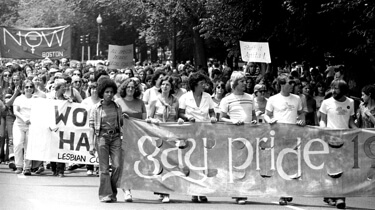 Exercise
Exercise
Tap all the highlighted words in the article below to see their definition. ⇩This month, we celebrate an important turning point—the first official steps in the fight for inclusion and equality.
Two years ago, we celebrated the 50th anniversary of the first gay pride parade!
LGBTQ+ pride
Pride Month takes place every year in June. The celebration includes parades, parties, workshops, and more. Started in New York City with a single protest march, it’s now a worldwide event celebrated by millions.
Pride is a time to be proud of the contributions of LGBTQ+ people, to celebrate differences, and to remember those from the community who have died.
Read on to learn how it started!
Police harassment
In the 1960s, LGBTQ+ people were treated with extreme discrimination—they were harassed and beaten by police officers and rejected by society.
June 28, 1969, was no different. On that day at 1:20 a.m., police officers raided a popular gay bar called the Stonewall Inn. Their reason was that the bar had no liquor license. The customers were arrested and handcuffed.
Fighting back
Tired of constant harassment and homophobia, the patrons began rioting, even setting fire to a police barricade. For six days, protests continued, with thousands of people coming to show support.
One of the key participants of the Stonewall riots (also known as the Stonewall uprising), was Marsha P. Johnson, an African-American transgender woman and LGBTQ+ activist. Following the riots, she would become an important part of the fight for gay rights.

The first march
One year later, on June 28, 1970, the first protest march was held in New York City. It brought out more than 3,000 participants. That march was organized by Brenda Howard, a bisexual activist who was known as the “Mother of Pride.”
The flag
The rainbow flag is an important part of Pride. Gilbert Baker, an openly gay man and drag queen, designed it in 1978 in San Francisco to represent the LGBTQ+ community.
Baker’s original design had eight colours, but it was eventually changed to six. Each colour has a special meaning: red for life, orange for healing, yellow for sunlight, green for nature, blue for harmony, and purple for spirit.
In 2017, wanting to be more inclusive of people of colour, Philadelphia unveiled a new flag that included brown and black.
Celebrate all people
This Pride Month, let’s remember that people’s differences shouldn’t just be accepted—they should be celebrated!
 Exercise
Exercise
Now complete the comprehension quiz below.Pride Month Comprehension

Sadly, there’s still a long way to walk to reach the complete equality and acceptance. Thank you!
Change is now.
Each of us contributes by making only positive comments and not repeating patterns of society. We have to have empathy for the suffering that everyone carries inside Emotional and physical abuse.
All persons needs respect for the only condition to be a person. no matter what you believe, wear, eat, think, in your culture or religion. we need respect